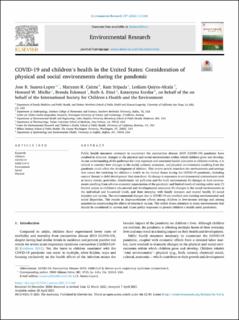| dc.contributor.author | Suárez-López, José R. | |
| dc.contributor.author | Cairns, Maryann R. | |
| dc.contributor.author | Sripada, Kam | |
| dc.contributor.author | Quirós-Alcalá, Lesliam | |
| dc.contributor.author | Mielke, Howard W. | |
| dc.contributor.author | Eskenazi, Brenda | |
| dc.contributor.author | Etzel, Ruth A. | |
| dc.contributor.author | Kordas, Katarzyna | |
| dc.date.accessioned | 2022-09-30T13:19:31Z | |
| dc.date.available | 2022-09-30T13:19:31Z | |
| dc.date.created | 2021-04-21T11:11:09Z | |
| dc.date.issued | 2021 | |
| dc.identifier.issn | 0013-9351 | |
| dc.identifier.uri | https://hdl.handle.net/11250/3022958 | |
| dc.description.abstract | Public health measures necessary to counteract the coronavirus disease 2019 (COVID-19) pandemic have resulted in dramatic changes in the physical and social environments within which children grow and develop. As our understanding of the pathways for viral exposure and associated health outcomes in children evolves, it is critical to consider how changes in the social, cultural, economic, and physical environments resulting from the pandemic could affect the development of children. This review article considers the environments and settings that create the backdrop for children's health in the United States during the COVID-19 pandemic, including current threats to child development that stem from: A) change in exposures to environmental contaminants such as heavy metals, pesticides, disinfectants, air pollution and the built environment; B) changes in food environments resulting from adverse economic repercussion of the pandemic and limited reach of existing safety nets; C) limited access to children's educational and developmental resources; D) changes in the social environments at the individual and household levels, and their interplay with family stressors and mental health; E) social injustice and racism. The environmental changes due to COVID-19 are overlaid onto existing environmental and social disparities. This results in disproportionate effects among children in low-income settings and among populations experiencing the effects of structural racism. This article draws attention to many environments that should be considered in current and future policy responses to protect children's health amid pandemics. | en_US |
| dc.language.iso | eng | en_US |
| dc.publisher | Elsevier | en_US |
| dc.relation.uri | https://www.sciencedirect.com/science/article/pii/S0013935121004540 | |
| dc.rights | Navngivelse 4.0 Internasjonal | * |
| dc.rights.uri | http://creativecommons.org/licenses/by/4.0/deed.no | * |
| dc.title | COVID-19 and children’s health in the United States: consideration of physical and social environments during the pandemic | en_US |
| dc.title.alternative | COVID-19 and children’s health in the United States: consideration of physical and social environments during the pandemic | en_US |
| dc.type | Peer reviewed | en_US |
| dc.type | Journal article | en_US |
| dc.description.version | publishedVersion | en_US |
| dc.source.volume | 197 | en_US |
| dc.source.journal | Environmental Research | en_US |
| dc.identifier.doi | 10.1016/j.envres.2021.111160 | |
| dc.identifier.cristin | 1905512 | |
| cristin.ispublished | true | |
| cristin.fulltext | original | |
| cristin.qualitycode | 2 | |

